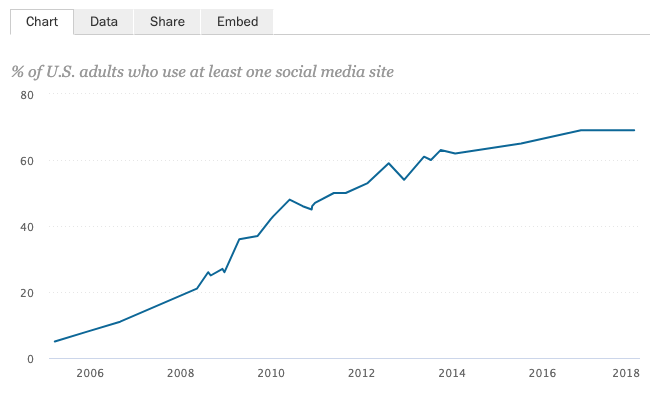
Social media is an important tool for spreading brand awareness, engaging with existing customers, and creating brand loyalty. It’s especially beneficial for small business owners, thanks to its low cost and easy accessibility.
Plus, 69% of the US adult population uses some type of social media, and there are 2.62 billion social media users worldwide. Whether your goal is to sell locally or to use your online store and international shipping to serve a larger audience, social media is the most effective channel to get more people aware of your shop.

Image source: Pew Internet
About one-third of consumers preferred way to communicate with a brand is through social media, and that presents a huge opportunity. Whether you want to take your social media strategy to the next level or are kicking it off for the first time, use this social media marketing mini-guide to get started on the right foot.
How to launch your brand on social media
- Research your local competition
- Choose your platforms
- Set clear goals
- Tap into local influencers
- Follow the 60/30/10 rule
1. Research your local competition
The best way to figure out what you should do on social media is to first see what your competitors are doing. This is called a competitor audit. Look at both what they’re doing and what’s working. For example, what’s driving engagement, like shares and comments? Don’t forget to look at both online and offline competitors, as long as they have the same audience as you, those insights are valuable.
Use this competitor research checklist as you audit each account. Create a spreadsheet to keep track of your findings; it’s a handy reference when you start planning out your own social media strategy. In your competitor audit, try to answer these questions for each competitor:
- Active accounts: which social media networks are your competitors using?
- Follower demographics: what’s the age, gender, and location of their target market?
- Content: what kind of content are they posting? (product shots, videos, lifestyle photos, educational content, etc)
- Content distribution: how much of each type of the above content types do they post?
- Timing and frequency: how many times a week are they posting content?
- Content engagement: which posts of theirs have the most shares, likes, comments, retweets, etc?
- Promotional content: what percentage of their posts are promotional?
- Influencers: which social media influencers are they partnering with?
When you’re finished, check your spreadsheet to find patterns, and use them as the starting point for your social media marketing.
For example
If you notice product shots like the one below are getting the most engagement on Instagram, plan those types of posts into your content calendar. Focus on creating content that has high engagement (likes, shares, comments, retweets, etc).

Image source: Oliver Peoples
2. Choose your platforms
Instagram, Pinterest, Twitter, Facebook, Snapchat; the list seems to grow bigger each year. Knowing which social media platform to use can be overwhelming when you have so many options. Rather than trying to leverage every available platform, take a step back and consider which social platform is best for your business, starting with your audit. Which one or two platforms were your competitors most active with or most commonly on?
Choose platforms that your target audience uses
Next, consider your audience demographics. For example, 78% of 18- to 24-year-olds use Snapchat, according to a Pew Research Center survey. If your target audience is age 65 and older, then Snapchat probably isn’t the best platform for your business. So, how do you find the right platform for your business?
Cross-reference the demographic data from your competitor audit with your own target market’s demographic data. Next, check out this full breakdown of social media demographics from Sprout Social to find out which social media platforms your target audience uses most. Choose one or two platforms that a high volume of your target audience uses and focus your energy on those.
Start small, then expand
With so little time, you’re better off focusing your energy on one or two social media platforms and doing really well, than focusing on three or more and doing poorly on each. You can always expand onto more social media networks later.
3. Set clear goals
One of the most important aspects of social media marketing is setting clear goals. Establishing short and long-term goals helps you establish the intent of your content and measure whether or not your content strategy is working.
For example
Let’s say you set a short-term goal to sell for $500 per month on Instagram. If mid-month you see that you’ve only sold for $50, you can adapt by posting content that features and promotes your products in different ways.

Image source: Saturday’s Surf NYC
There are five types of social media goals we recommend you focus on:
- Growth: getting more followers, more likes, more comments
- Revenue: generating more revenue through each social platform
- Traffic: scaling the total traffic bounced to your site from each platform
- Production: establishing a posting schedule and staying consistent
- Mindset-mantra: social media can be overwhelming; set a mindset goal to help you stay focused without feeling stressed or comparing your brand to others
Every small business should have at least one goal for each type — but the key is setting platform-specific goals. Instagram is a different type of social media platform than Facebook, with different strengths and capabilities. Your goal should reflect the nuances that make each platform unique.
Write your goals in a spreadsheet and set them on the first of each month. Look back as you set new ones to see what worked and what didn’t.
4. Tap into local influencers
Many small businesses are investing in micro-influencer marketing, which is when you partner with individuals that align with your brand to promote your products with authentic, visual posts on their social media accounts.
According to the Influencer Marketing Hub 2017 Study, influencer marketing is the fastest growing customer acquisition method, with 67% of the surveyed marketers saying they plan to increase their influencer marketing spend in 2018. And it’s no surprise why. Brands make an average of $6.50 for every $1 they spend in influencer marketing.

This type of marketing strategy has such a high return on investment because influencers act as social proof for your brand, encouraging those who follow and trust them to try your product. Since the recommendation is coming from a trusted source, that influencer’s followers are more likely to trust and try your brand.
Getting started with influencer marketing
To get started with local influencers, make a list of Instagram users who have at least 1,000 followers and whose aesthetic and lifestyle match your brand and what you sell. Send each of them a Direct Message outlining that, in exchange for their promotion, you’ll send them some free products. While some influencers are fine with exchanging free products for promotion, others prefer money, so be prepared for both.
Create a budget and stick to it — both for how many free products you can give away per month and how much you’re willing to pay each influencer.
5. Follow the 60/30/10 rule
According to SnapRetail, the 60/30/10 rule states that 60% of the posts you create should be engaging content that gets people reacting, commenting and sharing, 30 percent should be shared content, and 10 percent should be promoting your products and services, sales, events, etc.

- 60%: content that gets people engaged, commenting, liking and sharing
- 30%: shared content from your followers, influencers, etc
- 10%: content that promotes your products, services, sales, in-store events, etc
Following this rule ensures that the content you post is a healthy balance between inspirational, engaging and promotional. Although it might sound counterintuitive, posting too much promotional content is not a good thing. If all you do is push sales pitches, you won’t engage as much with your audience and eventually, they’ll tune you out.
Think of it this way, your audience is made up of individuals with thoughts, feelings, passions, and interests. By prioritizing engaging content over promotional content, you’re building your audience of loyal followers. Your goal is to engage with each of them and gain their trust so that when you push a promotional message, they listen.
Apply the 80/30/10 rule to maximize your engagements on social media with a mix of engaging, shared, and promotional content.
Start social media marketing to grow your brand
Use this guide to create your social media strategy and get the most out of what marketing on social media has to offer. Remember, before you even start building a content strategy you need to know:
- Who your competitors are
- What they’re doing
- Who your target audience is
With a clear picture of your competitors are and what they’re doing that’s working, and who your target audience is, you can build your content strategy. In it, you should:
- Find the social media platforms that your audience uses most
- Set clear short and long-term goals for each platform
- Use local influencers to engage with audiences that don’t directly follow you on social
- Follow the 60/30/10 rule to assure your content mix is engaging
If you take the time to research and plan your content to support your goals and your audience’s interests, you’ll be on the fast track to creating an active and engaged community and generating more brand awareness.

News you care about. Tips you can use.
Everything your business needs to grow, delivered straight to your inbox.



